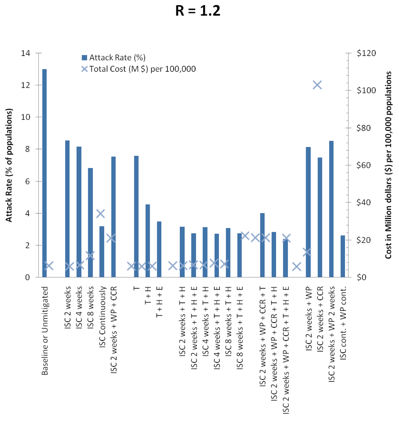National Health and Medical Research Council (NHMRC) Project
Grant:
Modelling to determine the cost effective strategies to mitigate
future influenza pandemics
We developed an integrated disease spread
and economic costing model to be used to determine the cost-effectiveness of a
range of mitigation strategies which may be used in a future influenza pandemic.
A highly-detailed, individual-based simulation model generates data on which
individuals become ill, their age, household and school/workplace location,
under a range of disease transmissibility and morbidity and mortality
characteristics. This data is used by an economic costing model to develop cost
metrics allowing interventions to be compared and optimal interventions to be
determined. Cost effective results will improve decision making by public
health authorities regarding establishing vaccine and antiviral drug
stockpiles.
Project partners:
·
Assoc. Prof Heath
Kelly, Victorian Infectious Disease Laboratory
·
Prof. Philip Clarke, School of Public Health, University of Melbourne
·
Assoc. Prof. Geoff Mercer, National Centre for Epidemiology and
Population Health, Australian National University
We are currently looking for PhD students
in this area.
Related Publications
-
Halder N, Kelso JK,Milne GJ, 2014 A model-based economic analysis of pre-pandemic influenza vaccination cost-effectiveness BMC Infectious Diseases 14(1):266
Kelso JK, Halder N, Milne GJ, 2013 Vaccination strategies for future influenza pandemics; a severity-based cost effective analysis. BMC Infectious Diseases 13(81)
-
Kelso JK, Halder N, Postma MJ, Milne GJ, 2013 Economic analysis of pandemic influenza mitigation strategies for five pandemic severity categories. BMC Public Health 13:211
Milne GJ, Halder N, Kelso JK, 2013
The cost effectiveness of pandemic influenza interventions:
A pandemic severity based analysis. PLoS ONE
8(4):e61504.doi:10.1371/journal.pone.0061504
Milne GJ, Kelso, Halder N, 2012
Lower NI efficacy may
significantly reduce pandemic intervention effectiveness [letter/rapid
response]. BMJ2012;345:e7304 rr/616540
Halder, N, Kelso JK, Milne GJ 2011
Cost-Effective
Strategies for Mitigating a Future Influenza Pandemic with H1N1 2009
Characteristics PLoS ONE, July 2011,
Volume 6, Issue 7, e22087

